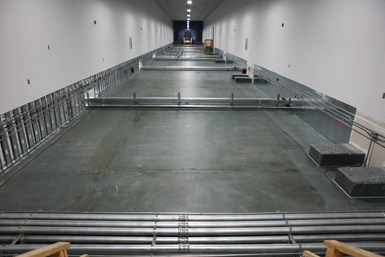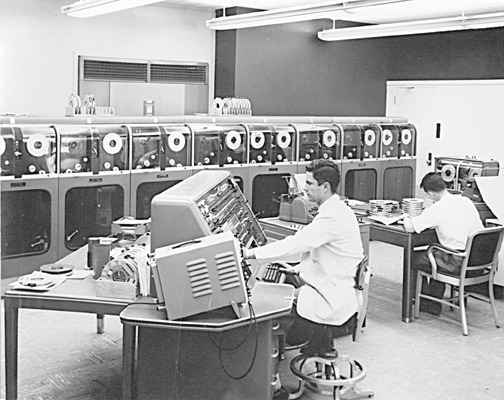Google likes to use the power usage effectiveness, or PUE, metric to calculate the energy costs of housing and cooling servers on server farms such as the one located in Lenoir, N.C. Now the “pee-yew” factor of a 9,000-head North Carolina hog farm is doing its part to offset Google’s carbon footprint guilt.
As a news release spelled out in September, a pilot waste-to-energy system constructed by Duke University and Duke Energy garnered the endorsement of Google Inc., which invests in high-quality carbon offsets from across the nation to fulfill its own carbon neutrality goals. The $1.2-million system, built at Loyd Ray Farms, a 9,000-head hog finishing operation northwest of Yadkinville, N.C., 25 miles west of Winston-Salem, converts hog waste into electricity and creates carbon offset credits.
“Duke University and Duke Energy have been developing the pilot project for nearly three years, with additional grant funding from the U.S. Department of Agriculture and the North Carolina Department of Environment and Natural Resources Lagoon Conversion Program,” said the Duke University release. “Duke Energy and the university will share operational and maintenance costs for the first 10 years of operation. Google will assume a share of the university’s portion of the costs in return for a portion of the carbon offsets for a 5-year term.
By capturing greenhouse gases from hog waste and burning them to run a turbine, the system produces enough electricity to power 35 homes for a year. It is expected to be able to prevent the release of greenhouse gases equivalent to nearly 5,000 metric tons of CO2 per year.
The Duke Carbon Offsets Initiative began looking at the project three years ago. Along the way, Sustainable Duke developed an individual carbon calculator, and the Offsets Initiative developed a Swine Farm Carbon Offset Estimator to help farmers and others interested in agricultural offsets estimate the amount of offsets that might be available on their farms.
Reducing the PUE

PUE (power usage effectiveness) measures how much overhead energy is required to house and cool the computers inside a building relative to the amount the computers consume themselves. “A PUE of 2.0 means that for every watt of IT power, an additional watt is consumed to cool and distribute power to the IT equipment,” explains Google’s own blog. “An ideal PUE would be 1.0, meaning that all of a data center’s power is consumed by the components that do the actual work that the data center is meant to do.
“As of Q2 2011, the trailing twelve-month (TTM), energy-weighted average PUE for Google data centers with an IT load of at least 5MW and time-in-operation of at least 6 months, is only 1.15, with some individual data centers as low as 1.11,” Google says. “These statistics exceed the US Environmental Protection Agency’s (EPA) most optimistic goal for data center efficiency. We achieved this result without the use of any exotic techniques that the EPA report assumes are necessary to reach this level of efficiency.”
In addition to the hog farm project, Google has pursued another methane-driven carbon offset agreement with the Landry Parish landfill in Louisiana. The company meticulously tracks its PUE and related metrics as they relate to renewables, carbon footprint and other sustainability factors.
A new report, “Growth in data center electricity use 2005 to 2010” by Prof. Jonathan Koomey of Stanford University, backed by The New York Times and published by Analytics Press, built upon earlier research by Koomey in reaching the following conclusions:
- “Electricity used by data centers worldwide increased by about 56 percent from 2005 to 2010 instead of doubling (as it did from 2000 to 2005), while in the U.S. it increased by about 36 percent instead of doubling.”
- “Electricity used in global data centers in 2010 likely accounted for between 1.1 percent and 1.5 percent of total electricity use, respectively. For the U.S. that number was between 1.7 percent and 2.2 percent.”
- “Electricity used in U.S. data centers in 2010 was significantly lower than predicted by the EPA’s 2007 report to Congress on data centers. That result reflected this study’s reduced electricity growth rates compared to earlier estimates, which were driven mainly by a lower server installed base than was earlier predicted rather than the efficiency improvements anticipated in the report to Congress.”
- “While Google is a high-profile user of computer servers, less than 1 percent of electricity used by data centers worldwide was attributable to that company’s data center operations.”
GE Reaches Platinum in Louisville
However, carbon emissions are another animal altogether. A 2008 McKinsey & Company study predicted carbon dioxide emissions from data centers would quadruple by 2020, exceeding that of the airline industry. So the push is on to make them as green as possible.
The U.S. Green Building Council has certified the data center at GE Appliances & Lighting in Louisville as the first data center in Kentucky to achieve Platinum-level certification (and only the third LEED-Platinum building of any kind in the Commonwealth).
The data center houses 128 cabinets holding high-density servers, and supports 27,000 employees in more than 100 countries.
Here are some key highlights of the project, according to GE:
- GE received 8 points on a 10-point scale for optimized energy performance in the data center. Specifically, the data center is 34-percent better in terms of energy savings than a typical code-compliant building.
- High-density computing means the company can squeeze more servers per square foot than the data center it replaces, resulting in less space to cool.
- Two 27,000-gallon thermal storage tanks help cool the facility.
- GE reused an existing building to avoid environmental impact of new construction; 98.3 percent of existing walls, roofs and floors were used. GE sourced 50.7 percent of construction materials regionally. The data center is built with 30.2 percent recycled content. GE diverted 85.4 percent of on-site generated construction waste from the landfill into recycling facilities.
- The building was constructed with low-emitting materials, including adhesives and sealants, paints & coatings, carpets, composite wood, agrifiber and more.
- GE has offset 35 percent of the data center’s predicted annual energy consumption through the purchase of off-site renewable energy.
- GE Digital Energy’s uninterruptable power supply (UPS) units with eBoost™ technology enable data centers “to achieve up to 99 percent UPS efficiency, without sacrificing reliability.”
- GE is reducing water consumption inside the building by 42 percent compared to the industry baseline by installing ultra low-flow fixtures. Outside the building, GE is reducing water consumption by 100 percent.
- The new data center will support over a $1 billion investment to upgrade major appliance product lines — including refrigeration, laundry, cooking, dishwashers and water — as well as lighting products, and create Manufacturing Centers of Excellence, which will result in about 1,300 new U.S. jobs by 2014.
